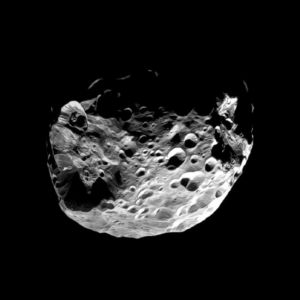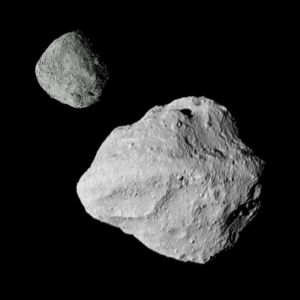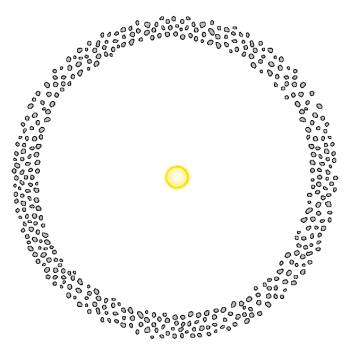Planetoid
Planetoids are the worldlets of a Belt. The Population, Government, and Law Level represent the general level throughout the Belt.
- An astronomical body too small to be considered a planet.
- The Universal Planetary Profile (UPP) uses a world size of 0 to designate an asteroid belt.
- Please also see Ringworld, Rosette, and Sphereworld.
Description (Specifications)[edit]
Generally any object less than 500 kilometers in diameter is considered to be a planetoid, although it may be called a moon if it is a satellite of a planet.
- For the purposes of distinction, the term asteroid belt is used to describe a planetoid belt which forms the main "world" in a stellar system.
Planetary Characteristics[edit]
The term planetoid belt refers to a belt of minor planets when another belt or world is the main world in a system.
- Asteroid and planetoid belts typically hold between 1,000 and 10,000 asteroids or planetoids each.
Probable Planetary Orbit & Climate[edit]
Planetoids strongly tend to be too small to collect an atmosphere and are generally uninhabitable. Larger planetoids tend to be termed moons or natural satellites. They tend to collect in orbits far from gas giants. Some astrophysical theories suppose that gas giants are natural shields against comets, and other dangerous objects.
History & Background (Dossier)[edit]
Planetoids generally cluster together in planetoid belts which encircle a star.
- These belts have a number of possible origins. For example, a planet may have failed to coalesce during the formation of its star system. It is also possible that a planet has been torn apart by tidal forces, leaving a path of scattered debris.
Asteroids vs. Planetoids[edit]
Asteroid and Planetoid Belts: The terms asteroid and planetoid are effectively synonymous; they mean small or minor planets. Each term refers to a belt of many similar small planets in orbit around the central star.
- For the purposes of differentiation, the term asteroid refers to such a belt when it is the main world of a system. The term planetoid belt refers to such a group of minor planets when another belt or world is the main world in a system.
- Asteroid and planetoid belts typically hold between 1,000 and 10,000 asteroids or planetoids each. [1]
Planetoid Hulls[edit]
Some classes of spacecraft utilize planetoids as hulls: these are noted as being Planetoid Hull or Buffered Planetoid Hull vessels. Denser nickel-iron planetoids are preferred, though some vessels use carbonaceous bodies. Most commonly, a chunk of material of a suitable size, density and internal structure is cut from a larger donor planetoid body. It is then towed to a shipyard and hollowed out, typically through the use of fusion tunneling.
- Only a limited percentage of the volume of a planetoid hull is usable: the remainder forms the structure of the hull. However, this structure affords the vessel integral armor. A Buffered Planetoid retains more of its natural structure, giving it better armor.
The surface of the planetoid vessel may be sculpted. This may be done to give the vessel a more conventional layout, particularly if it is to be carried aboard a larger vessel such as a Carrier or a Fleet Tender. A planetoid ship may also be sculpted to disguise it, making it seem like a natural body.
Final War Artifacts[edit]
Finally, many belts in and around the Third Imperium were formed by "planet-buster" super-weapons used in the Final War. These weapons used technologies with capabilities far beyond anything that TL-15 science can produce. It is widely thought that highly advanced antimatter weapons might have been one of those technologies.
References & Contributors (Sources)[edit]
- Marc Miller. Worlds and Adventures (Game Designers Workshop, 1977), .
- Marc Miller. Scouts (Game Designers Workshop, 1983), .
- Marc Miller. T5 Core Rules (Far Future Enterprises, 2013), .
- Martin Dougherty. A Guide to Star Systems (Mongoose Publishing, 2015), .
- Matthew Sprange. "Gas Giants, Planetoid, and other bodies." Journal of the Travellers' Aid Society volume 2 (2019): 80-85.
- Martin Dougherty. Referee's Handbook (Mongoose Publishing, 2021), 83-84.
- Beowolf's Libary Data Website
- ↑ Marc Miller. Scouts (Game Designers Workshop, 1983), 39.



